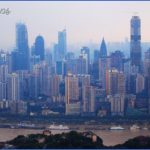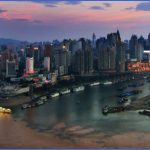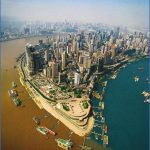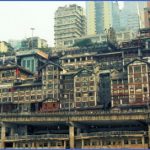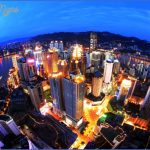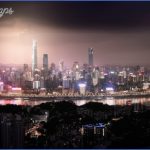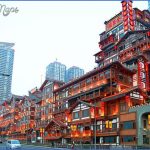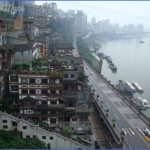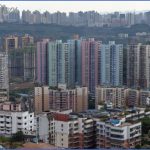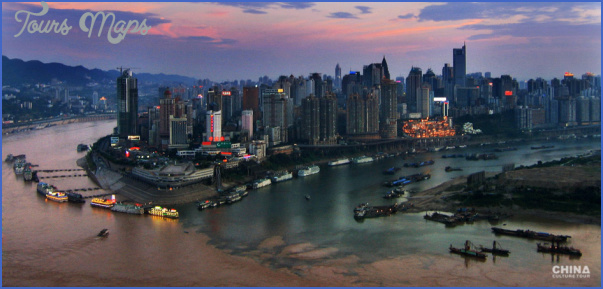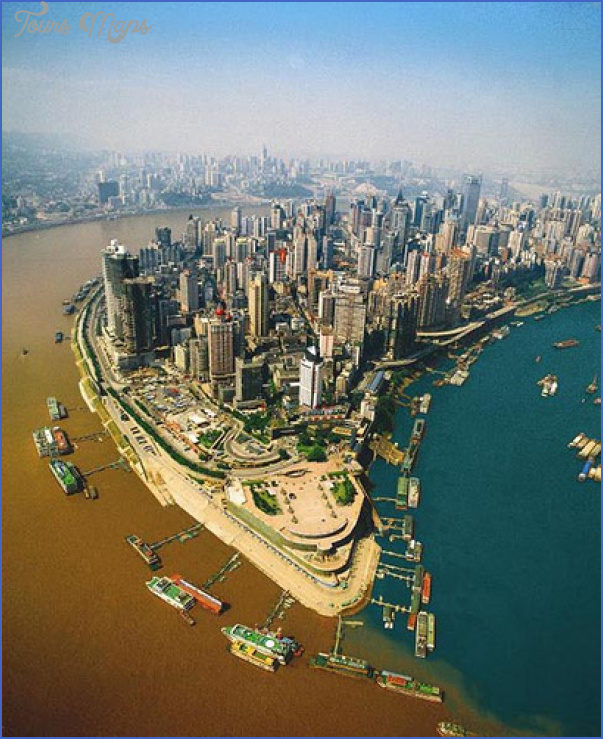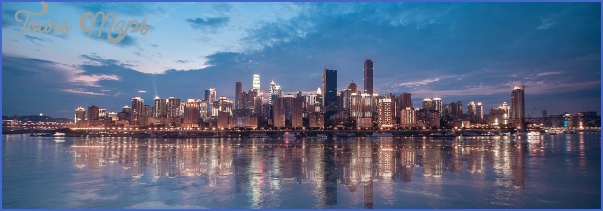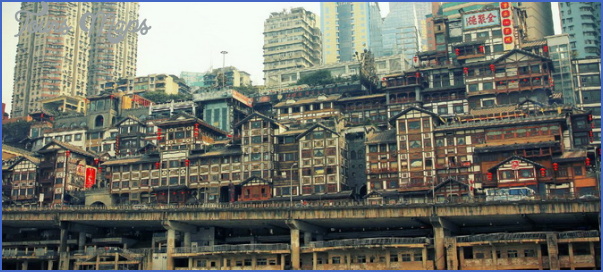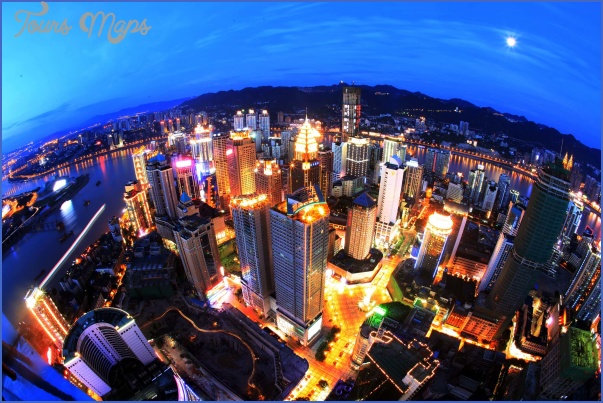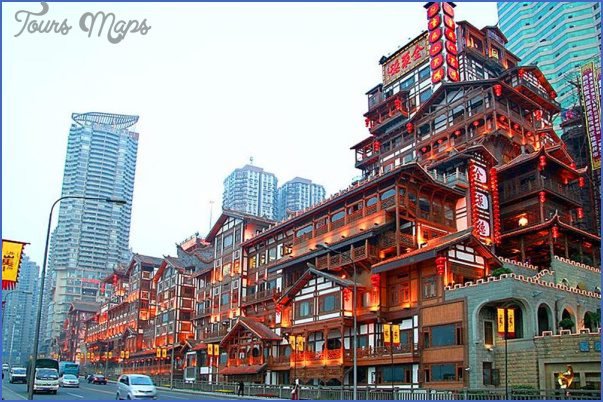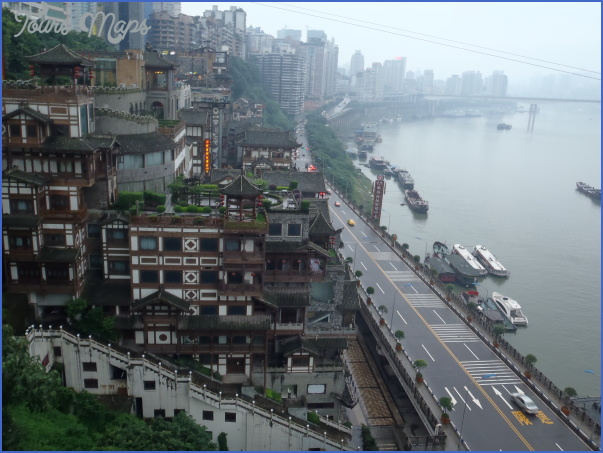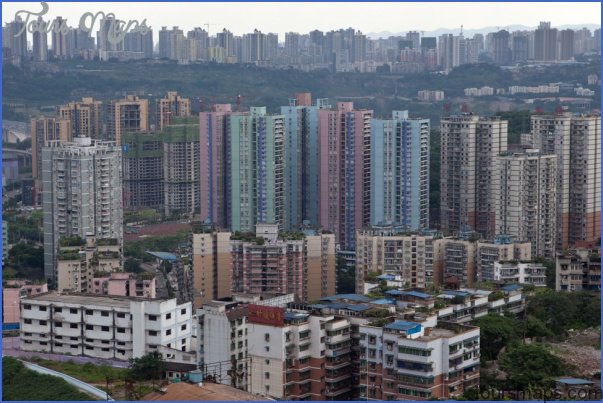Chinghai See Qinghai Chongqing Province: Sichuan
Altitude: 261m/857ft. Area: 1521sq.km/587sq. miles Population: 2,650,000 (conurbation 6,510,000)
Chongqing lies in the eastern part of Sichuan province, at the confluence of the Changjiang and Jialingjiang rivers, at longitude 106°29’E and latitude 29°39’N. The Old Town sprawls over a hill which is encircled by the two rivers. Chongqing is accessible by rail from Chengdu, the provincial capital, as well as by air from Beijing and Canton.
Loquat Hill Park (Pipashan)
Chongqing: old part of the town
Chongqing, also known as the “Mountain City”, is one of the country’s most important conurbations, and its mines and shipyards help to make it the political and commercial centre of south-west China. Chongqing University and other colleges mean that it is also of importance in the educational sphere.
Chongqing can boast a history going back more than 3000 years. As early as the 13th c. it was the capital of the Ba kingdom. Like many other Chinese towns and cities, it has borne a number of names in the course of its history – under the Sui dynasty (589-618) it was called Yuzhou, and then Gongzhou during the time of the Northern Song (960-1126). Its present name, which roughly translated means “double good fortune”, was conferred upon it by the Song Emperor Guangzong in 1189 in orderto celebrate two particularly favourable events in his political life, his appointments to Prince and then to Emperor.
At the time of the Japanese occupation the southern office of the central committee of the Chinese Communist party was housed in Chongqing. In 1939 it became the provisional capital of the Chinese Republic, as Nanjing was in the possession of Japanese troops. As a result, millions of people moved here from the eastern provinces and businesses and universities were transferred here too. After 1949 Chongqing’s economic development continued apace.
Loquat Hill towers to a height of 280m/920ft in the central/southern part of the Old Town, in the centre of Loquat Hill Park. From here there is a superb view of the whole city. Originally privately owned, the park was opened up to the public in 1955. On the top of the hill stands an octagonal pavilion. Nearby will be found the Municipal Museum in which are exhibited many archaeological specimens discovered in the city and the surrounding countryside.
The Southern HotSprings, lying 24km/15 miles south of Chongqing among some delightful scenery, are very popular with visitors. Built in the second half of the 19th c.,the baths are located in a beautiful park which has a brook running through it. The average temperature of the very sulphurous water is about 40°C/104°F.
Near the hot springs there are some other interesting sights, such as Fairy Mountain (Xiannuyou Yan), the Huaxi river, the Flying Waterfalls and an arched bridge.
The Natural History Museum lies in Bebei, a satellite town 45km/28 miles north-west of Chongqing. There are some 60,000 exhibits, of which the fossilised dinosaur remains are of particular interest; the local region is famous for the fact that these animals roamed here in prehistoric times.
The Northern Hot Springs rise north-west of Bebei (52km/32 miles northwest of Chongqing), in Wenfang Gorge near the Jialingjiang river, at the foot of Mount Jinyunshan. The free-flowing springs have an average temperature of about 35°C/95°F.
As well as the springs, the park-like surroundings also contain four Buddhist temples from the Ming and Qing periods (1368-1911); they are the Hall of the Great Buddha (Dafo Si) from 1432, which houses a giant statue of Shakyamuni, the Temple of Avalokiteshvara, the Temple of Ami-tabha and the Temple of General Guan Yu.
Red Cloud Mountain, 60km/37 miles north-west of Chongqing, is one ofthe most impressive mountains in the province. It is named after the Temple of the Red Clouds, built in 423, which was destroyed by fire in the middle of the 17th c. and rebuilt in 1683. The highest of its nine peaks, Jade Peak (Yujian Feng), is 1040m/3413ft high.
There are 50,000 or more stone sculptures at forty different sites all in the vicinity of Dazu, a little town 100km/62 miles west of Chongqing. Most of these historically and artistically valuable works – they include statues, bas-reliefs, high reliefs, etc. – are religious in character and represent Buddhas, Bodhisattvas and Buddhist, Taoist and Confucian saints, although some do portray scenes from everyday life as well as landscapes, animals and plants. The statues are either chiselled out of the hillsides or are housed in caves; the oldest date from the end ofthe Tang period, i.e. the 9th c., and many others are from the 12th c.
The most valuable of all are to be found on the slopes of Mount North (Beishan) and at the foot of Treasure Chamber Mountain (Baodingshan).
The largest collection of Mount North sculptures, hewn over a period of 250 years starting from 892 a.d., will be found near the town of Fowan (2km/11/4 miles north-west of Dazu), carved out of niches in a rock 7m/23ft tall and 500m/1641ft long. The work in the southern section was carried out between the 9th and 10th c., that in the northern section after the 10th c.
The beneficent Goddess of Mercy (Avalokiteshvara), carved in the middle of the 12th cž is also known as the “Chinese Venus”, because of her great beauty.
The Bodhisattvas Manjusri and Samantabhadra, riding on a lion or an elephant, represent the victory of good over evil as told in Buddhist teachings.
Between 1179 and 1249 more than 10,000 sculptures were carved at the foot of Treasure Chamber Mountain (Baodingshan), 15km/91/2 miles northeast of Dazu. The most beautiful are to be found in Dafowan, on a rock 15 to 30m/50 to 100ft high and 500m/1650ft wide. They depict Buddhist saints and episodes from their lives and work.
Buddha Also famous is the 30m/100ft long reclining statue of Buddha entering Nirvana. Many other carvings depict scenes from everyday life, some showing important events in a woman’s life, such as pregnancy, the birth and nursing of a child and its later marriage. Another group of figures is intended as a warning against the evils of alcohol – a father rejecting his drunken son, and a man so much under the influence of drink that he fails to recognise his own wife. zigong Dinosaur The quite exceptional Dinosaur Museum is located at the now famous Museum Dashanpu site some 11km/7 miles north of Zigong and 180km/112 miles west of Chongqing, where a great many, unusually well-preserved, dinosaur fossils were discovered. Skeletons of dinosaurs and other vertebrates are displayed in a 3600sq.m/39,OOOsq.ft exhibition area.
Chongqing Photo Gallery
Maybe You Like Them Too
- The Best Cities To Visit in The World
- World’s 10 Best Places To Visit
- Coolest Countries in the World to Visit
- Travel to Santorini, Greece
- Map of Barbados – Holiday in Barbados

